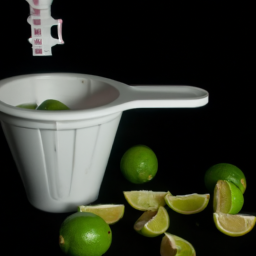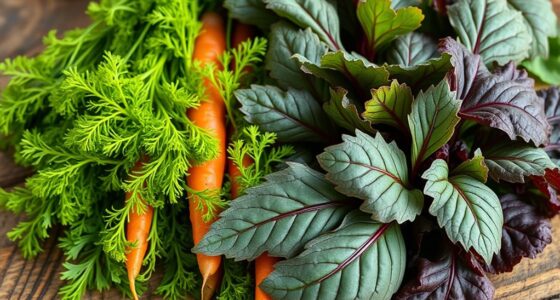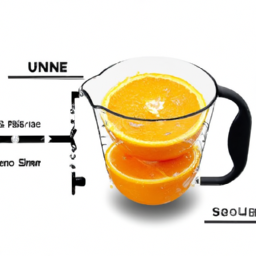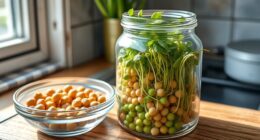When life gives you lemons, the saying goes, make lemonade. But what about when life gives you key limes instead? While these small, tangy citrus fruits may not be as popular as lemons, they are essential in many beloved recipes like Key Lime pie and ceviche.
However, when it comes to juicing key limes, there can be some confusion and variability in how much juice one can expect to get from each fruit.
In this article, I will explore the question of how many key limes are needed to yield 1 cup of juice. We will delve into the factors that can impact the yield of juice from key limes, including the variety of lime, its ripeness, and the juicing method used.
We will also offer tips for maximizing juice yield and highlight some alternative sources of key lime juice for those who may not have fresh limes on hand. So grab your juicer and let’s get squeezing!
Key Takeaways
- It takes about 12-15 small key limes to produce 1 cup of juice.
- The size of the limes can greatly impact the yield, so it’s always best to measure the juice to ensure accuracy.
- Rolling the limes on a hard surface before juicing or microwaving them for a few seconds to warm them up can help maximize juice yield.
- Choosing limes that are consistent in size is important to ensure recipes turn out perfectly every time.
Understanding the Variability in Key Lime Juice Yield
Did you know that the amount of juice per key lime can vary greatly? Factors affecting key lime juice yield include the ripeness of the fruit, the size of the lime, and even the season in which it was harvested.
In general, key limes tend to be smaller and have a thinner skin than other lime varieties, which can make their juice yield lower. However, this can also make the juice more flavorful and aromatic, which is why key lime juice is often preferred in recipes that call for limes.
When compared to other lime varieties, key limes tend to have a higher acidity level, which can also affect the amount of juice that is produced. Additionally, key limes are generally more difficult to juice than other lime varieties due to their smaller size and thicker skin.
Understanding the variability in key lime juice yield is essential for ensuring that you have enough juice for your recipe. So, how can you estimate key lime yield?
Estimating Key Lime Yield
So, when it comes to estimating key lime yield, I’ve learned that there’s a general rule of thumb to keep in mind. Typically, it takes about 12-15 small key limes to produce 1 cup of juice. However, it’s important to note that the size of the limes can greatly impact the yield. Therefore, it’s always best to measure the juice to ensure accuracy.
General Rule of Thumb
When making key lime juice, you’ll typically need about 8-10 key limes to yield one cup of juice, but don’t worry, it’s worth the effort for the tangy, refreshing taste. There are several factors affecting yield, such as the size and ripeness of the limes, as well as the juicing method used.
It’s important to harvest the limes at the ideal time, when they are fully ripe and have a slightly yellow skin, as this will give you the best yield. To get the most juice out of your key limes, roll them on a hard surface before juicing, or microwave them for a few seconds to warm them up.
Another trick is to juice the limes while they are still cold, as this will help prevent the bitter taste that can come from over-squeezing. Keep in mind that the size of the limes can also affect the yield, with smaller limes giving slightly less juice than larger ones.
Overall, though, as long as you follow these tips and use enough limes, you should be able to get a full cup of delicious key lime juice for your recipes. With this in mind, let’s move on to the next section about the importance of lime size.
Importance of Lime Size
The size of your lime is a crucial factor in determining the amount of tangy, refreshing flavor that will infuse your recipes. Key lime flavor can vary greatly depending on the size of the fruit used, so it’s important to choose the right size for your recipe.
If you’re using key limes for juicing purposes, it’s essential to pay attention to the size of each fruit to ensure that you’re getting the right amount of juice.
When it comes to recipe modifications, the size of your limes can make a big difference. Using larger limes will result in a less tart, more mellow flavor, while smaller limes will yield a more tangy and acidic taste.
Depending on the recipe you’re working with, you may need to adjust the amount of lime juice to achieve the desired flavor profile. With this in mind, it’s important to select limes that are consistent in size to ensure that your recipes turn out perfectly every time.
Choosing the right lime size is just one aspect of getting the most juice out of your limes. In the next section, I’ll share some tips for maximizing your juice yield so that you can extract as much flavor as possible from each lime.
Tips for Maximizing Juice Yield
To get the most juice out of your key limes, you’ll want to roll them firmly on the counter before cutting them in half. This breaks down the membranes inside the lime and allows for easier extraction of the juice.
Here are three additional tips for maximizing your juice yield:
-
Microwave the limes for 10-15 seconds before juicing them. This will soften the lime and make it easier to squeeze out all the juice.
-
Use a citrus reamer or a fork to extract the juice from the lime. While a citrus press is a popular option, using a reamer or fork will allow you to get more juice out of the lime.
-
Cut the lime in half crosswise, rather than lengthwise. This will give you more surface area to work with and make it easier to extract all the juice.
When it comes to juicing key limes, there are many techniques and tools you can use to get the most juice possible. In the next section, we’ll discuss the different tools and equipment you can use to make juicing key limes a breeze.
Tools and Equipment for Juicing Key Limes
Using the right tools and equipment can make juicing key limes a breeze. When it comes to juicing key limes, it’s important to choose the right juicer to maximize your yield and avoid common mistakes. There are two main types of juicers: manual and electric.
Manual juicers are great for small batches and are often less expensive than electric juicers. They require a bit of elbow grease, but they can be very effective in extracting the juice from key limes. Electric juicers, on the other hand, are more efficient and can handle larger quantities of key limes. They can be a bit more expensive, but they are a great investment if you plan on juicing key limes regularly. Some of the best techniques for juicing key limes include slicing the limes in half, using a reamer or citrus press to extract the juice, and using a strainer to remove any seeds or pulp.
When it comes to juicing key limes, having the right tools and equipment is essential. Recommended juicers include manual and electric options, each with their own benefits. However, it’s important to avoid common mistakes and choose the best techniques to maximize your yield. In the next section, we’ll explore alternative sources of key lime juice.
Alternative Sources of Key Lime Juice
Looking for a different way to add zesty flavor to your dishes? Check out these alternative sources for tangy key lime juice! Here are four options for using key lime juice in cocktails and cooking with alternative citrus juices:
-
Lime Juice: If you can’t find key limes, regular limes are a great substitute. They have a similar flavor and acidity that can easily replace key lime juice in recipes.
-
Lemon Juice: Lemon juice can also be used as a substitute for key lime juice. It has a similar level of acidity and tanginess, which can add a bright, fresh flavor to your dishes.
-
Grapefruit Juice: For a unique twist, try using grapefruit juice instead of key lime juice. It has a tart, sweet flavor that pairs well with seafood and salads.
-
Orange Juice: Orange juice is another great substitute for key lime juice. It has a sweet, tangy flavor that can add depth and complexity to your cocktails and dishes.
By experimenting with these alternative citrus juices, you can add a new level of flavor to your cooking and cocktails.
So, let’s move on to some delicious recipes using key lime juice!
Recipes Using Key Lime Juice
Get ready to tantalize your taste buds with some delicious recipes that incorporate the tangy and zesty flavor of key lime! One of my personal favorites is Key Lime Margaritas. To make this refreshing cocktail, you’ll need 1 cup of fresh key lime juice, 1 cup of tequila, 1/2 cup of orange liqueur, and 1/2 cup of simple syrup.
Combine all of the ingredients in a shaker with ice, shake until well mixed, and serve in salt-rimmed glasses with a slice of lime for garnish. This recipe is perfect for a summer day and is sure to impress your guests!
Another great way to use key lime juice is in a marinade. Try this Key Lime Marinade for a flavorful twist on grilled chicken or fish. To make the marinade, mix 1/4 cup of fresh key lime juice, 1/4 cup of olive oil, 2 cloves of minced garlic, 1 tablespoon of honey, and a pinch of salt and pepper.
Place your protein of choice in the marinade for at least 30 minutes (or up to overnight), then grill or bake as desired. The tangy and sweet flavors in this marinade will add a burst of flavor to any dish.
Now that you know some delicious recipes that use key lime juice, let’s move on to choosing the right key limes for maximum flavor.
Choosing the Right Key Limes
When it comes to choosing the right key limes for my recipes, I always make sure to look for the right variety and quality. I personally prefer the Mexican key lime variety for its tartness and stronger flavor compared to the Persian key lime.
To identify quality limes, I check for firmness, smoothness, and a bright green color.
Varieties of Key Limes
As I slice open the small, round key lime with its thin, yellow-green rind, I immediately notice the distinct aroma and tart flavor that sets it apart from other lime varieties. The key lime flavor is unique and can be described as a combination of sour, acidic, and slightly sweet.
The key lime seasonality typically runs from June to September, but it can vary depending on the region and climate. There are two main varieties of key limes: the Mexican and the Florida key lime.
The Mexican key lime is smaller, rounder, and has more seeds than the Florida key lime. It has a stronger, more acidic flavor and is often used in Mexican cuisine. The Florida key lime, on the other hand, is larger, more oval-shaped, and has a smoother texture. It has a slightly sweeter flavor and is commonly used in desserts such as key lime pie.
Identifying quality limes is essential to getting the most flavor and juice out of your key limes.
Identifying Quality Limes
As we learned in the previous subtopic, there are several different varieties of key limes. However, no matter which type of key lime you choose, identifying quality limes is crucial for making the best juice.
When it comes to identifying quality limes, there are two main factors to consider: ripeness and freshness. Here are three tips to help you evaluate the quality of your key limes:
-
Comparing Ripeness – When selecting key limes, look for fruits that are firm and heavy for their size. Avoid limes that are soft or have dark spots, as these are signs of over-ripeness. Key limes should be bright green in color, with a slightly yellow tinge, indicating that they are ripe and packed with flavor.
-
Evaluating Freshness – The freshness of key limes is also key to making delicious juice. To ensure freshness, look for limes with smooth, shiny skin and a mild fragrance. If the scent is too strong or sour, the limes may be past their prime. Additionally, be sure to avoid limes that have been sitting out at room temperature for too long, as this can cause them to dry out and lose flavor.
By following these simple tips, you can identify the best quality key limes for making juice that is bursting with flavor.
Now, let’s move on to the next section where we’ll discuss how to store and preserve your key limes for optimal freshness and taste.
Storing and Preserving Key Limes
I often wonder if I can substitute regular limes for key limes in my recipes. Another concern is how long key limes can last, and how to properly store and preserve them. Additionally, I’m curious if using bottled lime juice is a viable option for my key lime pie recipe.
These are important questions to consider for anyone who loves cooking with key limes.
Can I Substitute Regular Limes for Key Limes?
You can use regular limes instead of key limes, but keep in mind that it may take around 6-8 regular limes to yield 1 cup of juice. While key limes have a distinct flavor profile that adds a tangy and slightly sweet taste to dishes, regular limes can still be used as a substitute if key limes are not available. However, it is important to note that the taste may differ slightly, as key limes are more aromatic and have a higher acidity than regular limes.
To give you a better idea of the difference between key limes and regular limes, here is a comparison table:
| Key Limes | Regular Limes |
|---|---|
| Smaller and rounder | Larger and oval-shaped |
| Yellow-green when ripe | Green when unripe, yellow when ripe |
| More aromatic and acidic | Less aromatic and acidic |
| Thin skin and juicy | Thicker skin and less juicy |
While regular limes can be used as a substitute for key limes, it is important to consider the difference in taste and acidity. If you are looking for the distinct flavor profile that key limes provide, it may be worth seeking them out. In the next section, we will discuss how long key limes can last when stored properly.
How Long Do Key Limes Last?
Wondering how long your key limes will last? With proper storage in a cool, dry place, they can stay fresh for up to two weeks. However, it’s important to note that the shelf life of key limes can vary depending on their ripeness at the time of purchase and how long they have been stored before being sold.
If you notice any signs of mold or spoilage, it’s best to discard them immediately. To extend the shelf life of key limes, it’s recommended to store them in the refrigerator. You can also freeze freshly squeezed key lime juice for later use in your favorite recipes.
Proper storage tips can help you get the most out of your key limes and ensure that they are fresh and delicious when you’re ready to use them. Speaking of using them, have you ever considered using bottled lime juice for your key lime pie?
Can I Use Bottled Lime Juice for Key Lime Pie?
If you’re looking for a shortcut, using bottled lime juice is a viable option for making Key Lime Pie. However, there are some important considerations to keep in mind when deciding between fresh and bottled juice. Fresh juice has a brighter, more vibrant flavor that can add depth and complexity to your pie. On the other hand, bottled juice is convenient and can save you time and effort in the kitchen.
When using bottled lime juice for Key Lime Pie, it’s important to choose a high-quality brand that is specifically designed for baking. Some of the best brands of bottled juice for baking include Nellie and Joe’s, Santa Cruz Organic, and ReaLime. These brands are made from 100% lime juice and contain no added sugars or preservatives, ensuring that your pie will have a pure, natural flavor. Ultimately, whether you choose to use fresh or bottled juice is a matter of personal preference. Both options can yield delicious results, so it’s up to you to decide which one is right for your recipe.
| Brand | Size | Price |
|---|---|---|
| Nellie and Joe’s | 16 oz | $3.59 |
| Santa Cruz Organic | 16 oz | $5.99 |
| ReaLime | 15 oz | $1.99 |
Using bottled lime juice for Key Lime Pie is a valid option, but it’s important to consider the flavor and quality of the juice you choose. By selecting a high-quality brand that is specifically designed for baking, you can ensure that your pie will have a delicious, natural flavor that will impress your guests. Whether you choose fresh or bottled juice, the most important thing is to have fun in the kitchen and enjoy the process of creating a scrumptious dessert.
Frequently Asked Questions
What other types of citrus fruits can be used as a substitute for key limes in recipes?
When it comes to substitutes for key limes in recipes, options include regular limes, lemons, and even grapefruit. Each brings a unique flavor profile to dishes. Best recipes using different citrus fruits can be found online or in cookbooks.
Can key limes be frozen for later use?
Yes, key limes can be frozen for later use. Simply wash and dry them thoroughly, then seal them in an airtight container or freezer bag. When ready to use, thaw them at room temperature for a few hours before juicing. This is a great way to ensure you always have fresh lime juice on hand for your recipes.
How do you know when a key lime is ripe and ready to use for juicing?
To determine key lime ripeness for juicing, squeeze the fruit gently. Ripe limes will give slightly under pressure and have a strong citrus smell. Use a juicer or reamer to extract juice and adjust acidity levels with a pH meter or taste testing.
Is it necessary to strain key lime juice before using it in recipes?
To strain or not to strain key lime juice is a matter of personal preference. Straining removes pulp and seeds, resulting in a smoother texture. However, some recipes benefit from the added texture and flavor of the pulp.
Are there any health benefits to consuming key limes or key lime juice?
I’ve found that key lime juice is packed with vitamin C and antioxidants, which can improve immune function and promote healthy skin. To incorporate key limes into your diet, try adding the juice to salad dressings or making a refreshing key lime pie.
Conclusion
So, in the end, the question remains: how many key limes do you need to yield 1 cup of juice?
The answer, unfortunately, isn’t a simple one. It all depends on the size, ripeness, and juiciness of your key limes. But fear not, by understanding the variability in key lime juice yield and utilizing some tips and tools for maximizing juice yield, you can ensure that you get the most juice out of your key limes.
As the saying goes, when life gives you lemons (or key limes), make lemonade (or key lime pie). So go forth and experiment with the delicious and tangy flavors of key lime juice in your cooking and baking.
Just remember to choose the right key limes, store and preserve them properly, and have fun with the juicing process. Because at the end of the day, the joy is in the journey, not just the destination.
Ilana has been a vegan for over 10 years. She originally made the switch for health reasons, but soon found herself becoming more and more passionate about the ethical and environmental implications of a vegan lifestyle. Ilana is the author of The Graceful Kitchen, a blog all about veganism. She loves to cook up delicious and nutritious vegan meals, and share her recipes with others who are interested in leading a cruelty-free life. Ilana is also a strong advocate for using whole foods as the foundation of a healthy diet, and believes that going vegan is one of the best ways to achieve this.










